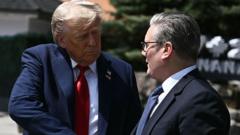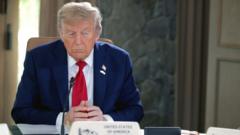U.S. stocks rose sharply following President Trump's temporary suspension of most tariffs for three months, yet tensions with China escalate as tariffs on Chinese exports increase to 125%.
Trump Signals Trade Shift with Temporary Tariff Suspension

Trump Signals Trade Shift with Temporary Tariff Suspension
In a surprising turn, President Trump announces a 90-day pause on tariffs, excluding China, amid a volatile trade environment.
Article Text:
In an unexpected move, President Trump has announced a 90-day suspension of reciprocal tariffs on several countries, a decision that sent U.S. stocks soaring. However, Trump made it clear that this pause excludes China, where tariffs on U.S. exports will see a drastic rise to 125 percent. This escalation follows China’s recent increase of its tariffs on U.S. goods to 84 percent, intensifying the ongoing trade conflict between the two largest economies.
According to the White House statement, the overall tariff level will be reduced to 10 percent for most nations, although Canada and Mexico, significant trading partners, will not be affected by this adjustment. These developments come in the wake of the European Union confirming its first retaliatory tariffs and a downturn in U.S. bond markets, traditionally viewed as a refuge during economic uncertainty.
When asked about the reasoning behind this sudden policy shift, Trump remarked that he felt the public was “jumping a little bit out of line” and becoming overly anxious. He conveyed optimism, stating that “nothing is over yet” and indicated that numerous countries—more than 75—are exploring potential trade agreements. A senior Treasury official reiterated that the change in tariff policy had been part of Trump's strategic plan from the beginning.
In an unexpected move, President Trump has announced a 90-day suspension of reciprocal tariffs on several countries, a decision that sent U.S. stocks soaring. However, Trump made it clear that this pause excludes China, where tariffs on U.S. exports will see a drastic rise to 125 percent. This escalation follows China’s recent increase of its tariffs on U.S. goods to 84 percent, intensifying the ongoing trade conflict between the two largest economies.
According to the White House statement, the overall tariff level will be reduced to 10 percent for most nations, although Canada and Mexico, significant trading partners, will not be affected by this adjustment. These developments come in the wake of the European Union confirming its first retaliatory tariffs and a downturn in U.S. bond markets, traditionally viewed as a refuge during economic uncertainty.
When asked about the reasoning behind this sudden policy shift, Trump remarked that he felt the public was “jumping a little bit out of line” and becoming overly anxious. He conveyed optimism, stating that “nothing is over yet” and indicated that numerous countries—more than 75—are exploring potential trade agreements. A senior Treasury official reiterated that the change in tariff policy had been part of Trump's strategic plan from the beginning.






















